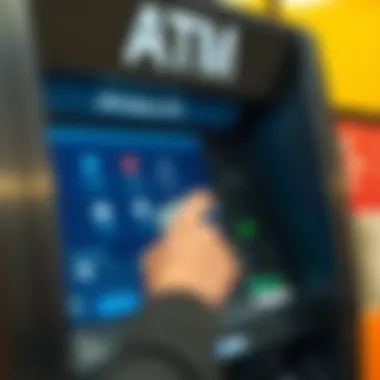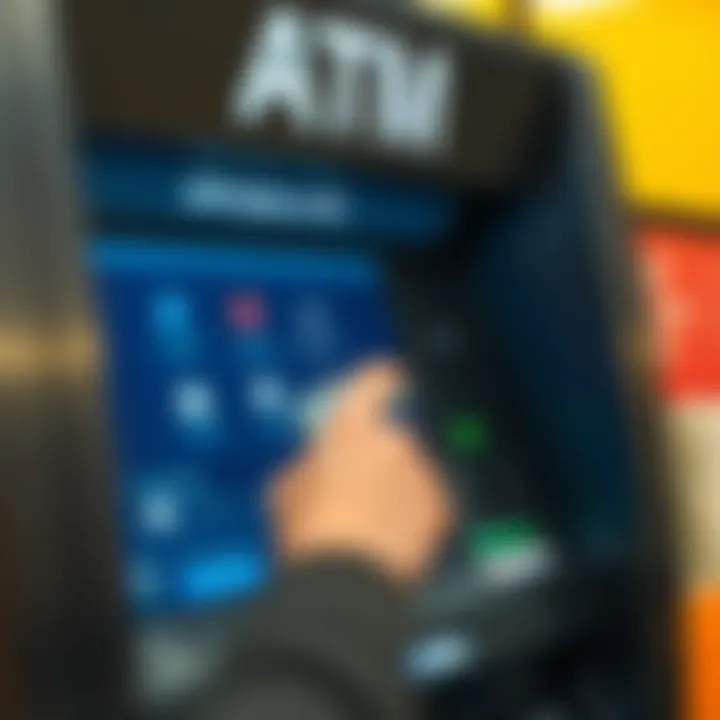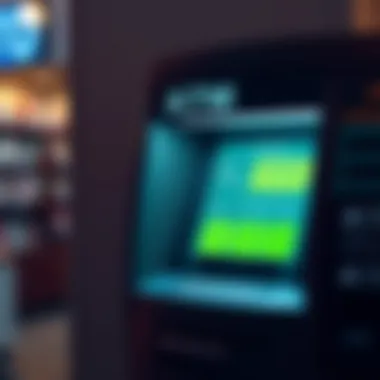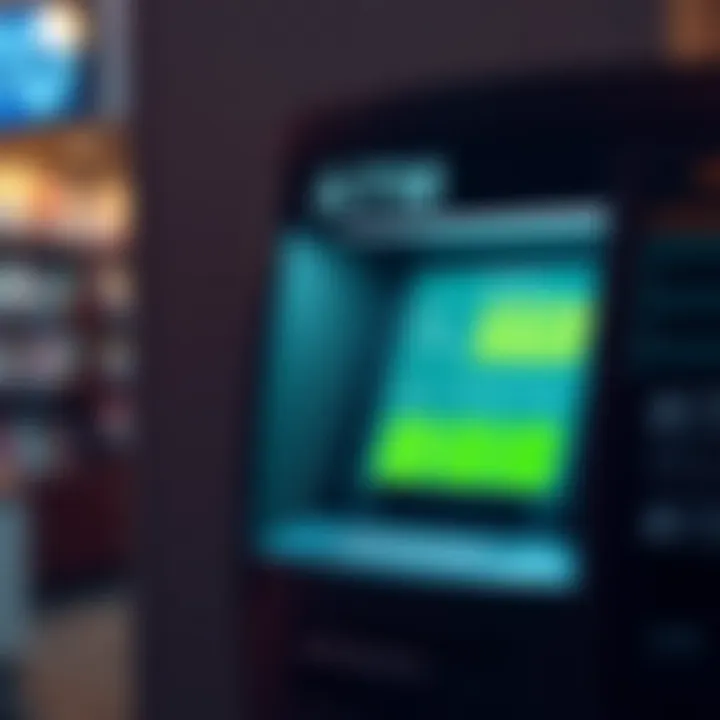Navigating ATM Deposits Across Different Banks


Intro
Navigating the world of banking can often feel like traversing a maze, especially when it comes to using ATMs for depositing funds. Most folks assume that popping into any ATM will be a straightforward affair, but when it comes to non-parent bank ATMs, complexities can arise that are worth examining. This article delves into the nitty-gritty of depositing cash at ATMs that belong to banks other than your own, providing essential insights into the practices, fees, and policies that govern these transactions.
Understanding how to effectively navigate the banking landscape, particularly regarding ATM deposits, is crucial for savvy investors and everyday users alike. As technology evolves, these interactions will not only become more prevalent but may also change in nature. By digging into factors such as fee structures, transaction limits, and the advantages and drawbacks of utilizing various bank ATMs, readers can arm themselves with the knowledge needed to make informed decisions.
In a digital age where convenience is king, being aware of the implications and processes involved in ATM usage can save you time and money. Let’s embark on this exploration together, illuminating the path ahead to better cross-bank banking experiences.
Understanding ATM Functionality
Understanding how ATMs work is crucial for anyone who engages in banking outside their primary financial institution. This section sets the stage for comprehending the broad spectrum of ATM usage, particularly as it pertains to making deposits at ATMs belonging to different banks. Knowing the functionality of these machines reveals their potential and constraints, enabling users to navigate their banking activities more efficiently.
The importance of ATM functionality extends beyond basic transactions. By understanding how ATMs operate, individuals can anticipate potential fees, realize the extent of their banking options, and enhance their financial literacy. Furthermore, grasping the nuances of how ATMs differ from one another enables informed decisions, ultimately contributing to smarter banking practices.
What is an ATM?
An Automated Teller Machine, commonly known as ATM, is a computerized device that allows bank customers to perform financial transactions without the need for human assistance. These machines offer various features such as cash withdrawals, fund transfers, account inquiries, and—most pertinent to this discussion—deposits. ATMs can frequently be found in high-traffic areas like shopping centers, airports, and bank branches.
While the basic function of an ATM remains similar across the board, the specific features may differ based on the bank's policies and technology. For instance, some may accept check deposits while others focus solely on cash. Understanding what type of transactions can happen at an ATM is essential for anyone looking to use different bank ATMs effectively.
Different Types of ATMs
Not all ATMs are created equal. Their functionality can range from simple cash withdrawal machines to advanced options that allow for a variety of banking services. Here are some common types:
- Traditional ATMs: These provide basic functions like cash withdrawals and balance inquiries.
- Deposit ATMs: Equipped with the capability to accept cash and check deposits directly into the user's account, typically with immediate or delayed processing.
- Smart ATMs: These are equipped with advanced technology that may offer features like touch screens, bill payments, and even video consultation with bank representatives.
- Off-Premise ATMs: Often found in convenience stores or gas stations, these machines may have different fee structures and functionalities depending on the hosting institution.
Not only does recognizing these types help customers make informed decisions, but it also underscores the importance of their functionality when depositing funds. Understanding the specific capabilities and limitations of various ATMs is essential for maximizing convenience and minimizing any unexpected costs associated with banking at third-party machines.
The Basics of ATM Deposits
Understanding ATM deposits is crucial for anyone looking to utilize bank networks more efficiently. With the rise of digital transactions, relying solely on traditional banking methods feels like bringing a knife to a gunfight. Here, we explore the simplicity and functionality of ATM deposits, examining their importance and why they deserve attention.
When making a deposit through an ATM, individuals often prioritize convenience. The ability to deposit cash or checks at any time adds significant value in our fast-paced world. This flexibility vastly outweighs the limitation of standard banking hours thus streamlining our financial transactions. Moreover, understanding key elements in ATM deposit processes can save one time and money—especially considering potential fees.
How ATM Deposits Work
ATM deposits are quite straightforward yet involve several underlying mechanisms that can vary greatly from bank to bank. In essence, the process begins when a user approaches an ATM and selects the deposit option. The system prompts for the insertion of cash or checks, which are scanned and authenticated. The machine typically combines technology such as bill validators and image capture systems to ensure accuracy. Once the details are processed, the transaction is completed by crediting the deposited amount to the user's account.
It's also helpful to note that the funds deposited through an ATM might not be immediately available. Different banks have different policies regarding the clearing periods. This can lead to unexpected hurdles when planning expenses or managing accounts. Additionally, certain banks provide ATM software that allows deposits in multiple currencies, broadening the scope for users traveling abroad.
Steps to Make a Deposit
Making a deposit at an ATM is a relatively simple process, but it requires attention to detail to prevent errors. Here’s a breakdown of the steps:
- Locate an ATM: Ideally, find one that belongs to your bank to avoid unnecessary fees.
- Insert Your Card: Begin by swiping or inserting your debit card into the machine.
- Enter Your PIN: Input your Personal Identification Number for security verification.
- Select Deposit: Choose the deposit option from the menu.
- Follow Prompts: Whether it’s cash or checks, the ATM will guide you on how to insert them properly.
- Review Transaction: Check the details on the screen to ensure accuracy before finalizing the process.
- Collect Receipts and Cards: Once complete, don't forget to collect your card and receipt as proof of transaction.


"Depositing money through an ATM remains one of the fastest ways to keep finances in check, especially when one is short on time or away from the home bank."
Can You Deposit Money at a Different Bank's ATM?
When it comes to banking, understanding how and where you can deposit your cash is crucial. The option to use different banks’ ATMs for making deposits opens up a whole new avenue of convenience and flexibility. This section will explore the nuts and bolts of using ATMs from banks other than your own, touching on various aspects that can affect your banking experience.
Bank Policies on Third-Party Deposits
As you set out to deposit money at an ATM not affiliated with your bank, you’ll quickly realize that bank policies dictate what is permissible. Being aware of these policies is vital. Most banks have varying protocols for accepting deposits from non-account holders. Some banks allow it, while others don’t, or they may have conditions tied to the transaction.
- Accepting Deposits: Banks like Chase or Wells Fargo tend to have more flexible policies and will allow you to deposit checks or cash, even if you don’t have an account with them. However, you might need to present identification.
- Deposit Limits: Banks often impose certain limits, like a daily cap on the amount you can deposit if you’re not an account holder. In these cases, be prepared to provide your account details and, in some instances, your ID as well.
Knowing these rules can save you from a troublesome situation. If you plan to deposit cash at, say, a Bank of America ATM with your Citibank account, ensure that you’ve done your homework on their deposit policy.
Eligibility and Limitations
While depositing at a different bank’s ATM can be convenient, there are important limitations to consider. Eligibility varies based on the financial institution and the type of account held. Understanding these terms will lay the groundwork for a smoother transaction.
- Eligibility: Not all banks are open to third-party deposits. Sometimes, smaller regional banks have stricter policies as compared to national banks. So, it might be a game of luck whether you can deposit or not.
- Transaction Fees: If you’re using an ATM that does not belong to your bank, expect fees. These fees can stack up quickly, especially if you make frequent deposits at different ATMs. Depending on the bank, they might charge for each deposit or a flat fee per transaction.
- Processing Time: Keep in mind that— in many cases— funds from non-affiliated bank deposits can take longer to process. Whether it's an internal check or cash deposit, you may not see your funds available as quickly compared to deposits made at your own bank’s ATM.
The complexities of banking policies highlight the necessity of understanding how different banks operate, especially when you plan to use an ATM not affiliated with your institution.
By being aware of these policies and limitations, you can navigate your banking transactions more effectively, ensuring you have access to funds when you need them.
Potential Fees Involved
Using different bank ATMs for deposits can lead to various fees that savvy consumers need to be aware of. Understanding these costs is crucial for making informed financial decisions. One might think that all ATMs are created equal, but that's far from the truth. Different banks impose their own rules and charges. This section aims to shine a light on those potential fees affecting deposits and what you should consider before choosing an ATM outside of your bank.
ATM Usage Fees
When you insert your card into an ATM that belongs to a bank different from yours, be prepared for the potential of an ATM usage fee. These fees can vary widely from one financial institution to another. It's a bit like picking apples from someone else's orchard; they're generally going to charge you for it.
- Common fee range: The average fee can range anywhere from $1 to $5, depending on the bank. Some prominent banking institutions may even charge more.
- Financial institutions often charge this fee as a way to compensate for the costs of operating and maintaining the ATM. This makes sense; if you're using their machine, they want to ensure it’s worth their while.
It's always good practice to check your bank's ATM fee structure, because some banks will reimburse these fees if you meet particular criteria, like maintaining a specific account balance. If your bank doesn’t offer such a benefit, then frequent usage of non-affiliate ATMs can lead to substantial costs over time.
"A penny saved is a penny earned," so paying attention to ATM fees can certainly add up in the long run.
Moreover, in today's competitive market, some banks have started forming alliances. For example, if your bank has a partnership with another bank, you may avoid ATM usage fees altogether when using those ATMs. Always keep an eye out for such partnerships. They can save you a pretty penny.
Deposit Processing Fees
In addition to the ATM usage fees, deposit processing fees also deserve your attention. When depositing cash or checks into an ATM not associated with your bank, you may face additional fees beyond just using the machine itself.
- What is at stake? These fees are often charged to handle the logistical aspects of processing your deposit. Think of it like paying for delivery when you order a pizza; there’s a process involved, and someone else is doing the work.
- Typical fee scenarios: Depending on the bank and your account type, these fees can range from $0.50 to $3.00.


Processing fees often apply more frequently to checks than to cash deposits. This is particularly important for those who regularly deposit business checks or personal checks that are not from their home bank. Always read fine print or inquire with customer service to know the ins and outs.
Advantages of Using Different Bank ATMs for Deposits
Utilizing ATMs from banks that are not your own can often be seen as a necessary inconvenience. However, there are undeniable advantages that can make this practice not just viable but also worthwhile. Understanding these benefits is crucial, especially for those who frequently find themselves needing to deposit cash when away from their primary bank. In this section, we will delve into two primary advantages: convenience and access to a wider network.
Convenience
When it comes to banking, convenience is king. Imagine it's a Saturday afternoon, and you've just come from a garage sale with a wad of cash in your pocket, only to remember that your bank branch closed hours ago. The pinch of panic sets in, as you search for a solution. Enter the ATM: a lifeline that is often available 24/7.
Using ATMs from different banks eliminates the need for planning around your bank's operating hours. These machines are typically scattered across various locations—from shopping malls to convenience stores—ensuring that you can deposit your funds when it works for you, not just when the bank allows it. Whether you're out running errands, traveling, or just caught in a busy workweek, this flexibility in accessing ATMs cannot be overstated.
Furthermore, many banks now offer technological features at their ATMs, allowing for cash deposits, check deposits, and even basic account management. With intuitive interfaces, these smart ATMs often simplify a typically tedious process, making it more straightforward to complete transactions with ease. This level of access is especially beneficial for those who might not be in proximity to their bank's physical branches, narrowing the gap between a person's banking needs and their ability to meet those needs in real-time.
Access to a Wider Network
The beauty of modern banking is the interconnected network of ATMs available across different institutions. When you choose to deposit money at various bank ATMs, you effectively tap into a broader network that can make accessing your funds easier than ever before. This expanding reach allows customers to interact with their finances from multiple vantage points, irrespective of where their primary banking relationship lies.
Consider this scenario: you’re on a business trip in a different city and need to deposit a significant amount of cash. The local availability of your bank's ATMs might be sparse, yet other banks have machines on nearly every corner. Accessing these machines means you can make deposits without unnecessary detours or inconveniences. Moreover, the synergy fostered by partnerships between banks and ATM providers often leads to increased functionality.
"Having a wide range of ATMs at your disposal is like having a map with multiple routes to your destination. It gives you choices and reduces the likelihood of delays."
This wider network is especially valuable for frequent travelers, expatriates, or anyone who simply lives far from their bank's home base. Having the ability to deposit money in unfamiliar locations can alleviate the stress of managing cash flow, thereby contributing to greater financial stability and peace of mind. Not to mention, for people who are often on the go, the flexibility afforded through access to varied ATMs in different banks can be a game-changer.
In summary, while there are certain considerations to weigh when it comes to using different bank ATMs for deposits, the convenience and broad network access offered cannot be overstated. As banking continues to evolve, being malleable with ATM usage can be a significant advantage.
Whether you are looking to quickly deposit money on a hectic schedule or needing to navigate financial obligations while traveling, knowing the leverage you have with multiple banking networks can enhance your overall banking experience.
Disadvantages and Risks
In the ever-evolving landscape of banking, some aspects might not shine as brightly, especially when it comes to using ATMs from different banks for deposits. It’s vital to understand the disadvantages and risks that pepper these transactions. They exist not only as potential inconveniences but also as significant hurdles that can affect your financial strategy.
Delayed Availability of Funds
One of the most considerable downsides is the delayed availability of funds after making a deposit. When you slide your cash into an ATM that belongs to a different bank, you might think you’ve completed a simple transaction. Nevertheless, it’s not always cut and dry. Banks have varying policies regarding the clearing of deposits, and in many cases, funds might not be available immediately.
- Hold Times Vary: Depending on the financial institution, a hold on your deposit could linger for days. If you’re used to instant access from your own bank’s ATMs, the waiting game can be frustrating.
- Timing Matters: Deposits made after business hours typically face longer hold time, as they might not be processed until the next business day.
The implications of this are significant, especially if you're relying on these funds for urgent expenses. It’s like trying to catch a bus that just left the station; you can see it, but you’re stuck waiting for the next one.
Fraud Concerns
Another crucial issue to consider is fraud concerns associated with using different bank ATMs for your transactions. While most banks adhere to rigorous security measures, the risk of fraud isn’t entirely eliminated.
- Increased Vulnerability: When you use a third-party ATM, you’re exposing your banking information to channels outside your primary bank’s security systems. If the ATM has been compromised by hackers, it could lead to unauthorized access to your account.
- Scams Afoot: There are various scams surrounding ATM usage, including card skimmers—devices that capture your card’s data as you insert it into the machine. Such risks underscore the importance of being vigilant when using any unfamiliar ATM.


Staying aware of your surroundings and regularly monitoring your accounts is crucial. Even a moment of inattention can lead to significant financial repercussions.
Technological Advancements in ATM Banking
In the rapidly evolving world of banking, technological advancements have reshaped the way users interact with Automated Teller Machines (ATMs). As consumers become increasingly reliant on digital solutions, banks have responded by integrating cutting-edge technology into ATM functionality. This section sheds light on such innovations and their significance, particularly for those who have to navigate deposits at different banks.
Smart ATMs and Their Capabilities
Smart ATMs are a game changer in the world of banking. Unlike traditional ATMs, which mainly offer cash withdrawal and basic account inquiries, smart ATMs provide a universe of services. They are equipped with touch screens, cash recycling capabilities, and the ability to deposit checks, which expands their functionality.
These machines often integrate advanced security features, such as facial recognition and encryption technologies, making transactions safer for users. For instance, a customer using their bank’s smart ATM can deposit cash and see immediate updates on their account balance.
- Here are some key capabilities of smart ATMs that enhance user experience:
- Cash Deposit: Users can deposit physical cash without needing to make a trip to their bank, and many machines immediately validate the notes.
- 24/7 Access: Contrary to limited banking hours, these ATMs can be accessed any time of day, providing more flexibility.
- User-Friendly Interface: With large touch screens and intuitive menus, even those less tech-savvy can navigate easily.
Smart ATMs showcase how technology can propel the banking experience into a new realm, ultimately benefiting those who need to carry out transactions at different banks' ATMs. By understanding their functionalities, users can maximize their banking convenience.
Remote Deposit Capture Technologies
Remote Deposit Capture (RDC) technologies represent another leap forward in ATM banking. Through this technology, account holders can deposit checks from the comfort of their own homes by simply taking a picture of the check via their mobile device. This eliminates the need to find an ATM, particularly useful for individuals who may not live close to their bank’s locations.
- The process generally involves a few straightforward steps:
- Log Into Mobile Banking App: Users access their bank's mobile application.
- Select 'Deposit' Option: They choose the RDC feature, which often provides prompts to guide them through the deposit process.
- Capture Images: Users must take a clear photo of both the front and back of the check.
- Submit: After confirming all details, the user submits the deposit.
This innovation not only optimizes convenience but also reduces the risks associated with carrying cash or checks, particularly when using ATMs in unfamiliar locations. Moreover, the funds typically become available quicker than traditional deposits.
In summary, technological advancements in ATM banking, such as smart ATMs and remote deposit capture technologies, are not just buzzwords. They turn everyday banking practices into a streamlined experience. Understanding these developments can aid users in making informed decisions about how to effectively and efficiently conduct their banking activities.
Epilogue
Using ATMs from banks that are not your own can indeed be a practical solution for many depositors. However, understanding the nuances tied to this practice is crucial for making informed decisions. Firstly, it’s important to be aware of the banking policies concerning third-party deposits. These guidelines vary significantly across institutions, leading to differences in what’s acceptable and what’s not. Knowing these rules can save one from unexpected fees or the frustration of a declined transaction.
Navigating the ATMs: Best Practices
To ensure a smooth experience while using a different bank's ATM for deposits, follow some best practices:
- Research ATM Locations: Before heading out, use your bank's app or website to find friendly ATMs that accept deposits. Not all ATMs are made equal and some may not accept transactions from external banks.
- Check Deposit Cut-off Times: Many banks have specific times when they process deposits. Understanding these will help you avoid delays in fund availability.
- Be Mindful of Fees: Always confirm if your bank imposes charges for using another bank's ATM. Even if the convenience seems enticing, fees can overshadow any advantage.
- Look for Error Notifications: When depositing, look out for any alerts or error messages during the transaction. If something feels off, it’s wise to reconsider or contact your bank for clarity.
- Keep a Receipt: Always keep transaction receipts for your records. This could be indispensable should any discrepancies arise.
"Familiarize yourself with the ATM policies and procedures to avoid any pitfalls in your banking journey."
Future of ATM Deposits
The future of ATM deposits is looking at substantial transformation, spurred by technology. Here are a couple of trends to watch out for:
- Smart ATMs are growing in popularity. These advanced machines not only allow for deposits but also include functionalities such as check scanning, account management features, and enhanced security measures.
- Digital Integration is another buzzword. As mobile banking apps evolve, users might witness features like remote deposit capture, which allows users to deposit checks by simply taking a picture with their smartphones. This trend exemplifies a shift toward convenience and efficiency.
- Increased Security Measures: As fraud concerns linger, many banks are investing in sophisticated security features for ATMs. Expect to see biometric verifications like fingerprint or face recognition becoming standard in coming years.
Thus, staying informed about ATMs, their functionalities, and the evolving technology will empower users to utilize banking services efficiently.
In summary, understanding how to navigate different bank ATMs for deposits enables a smoother banking experience. By being proactive and informed, users can harness the advantages while mitigating potential downsides.



